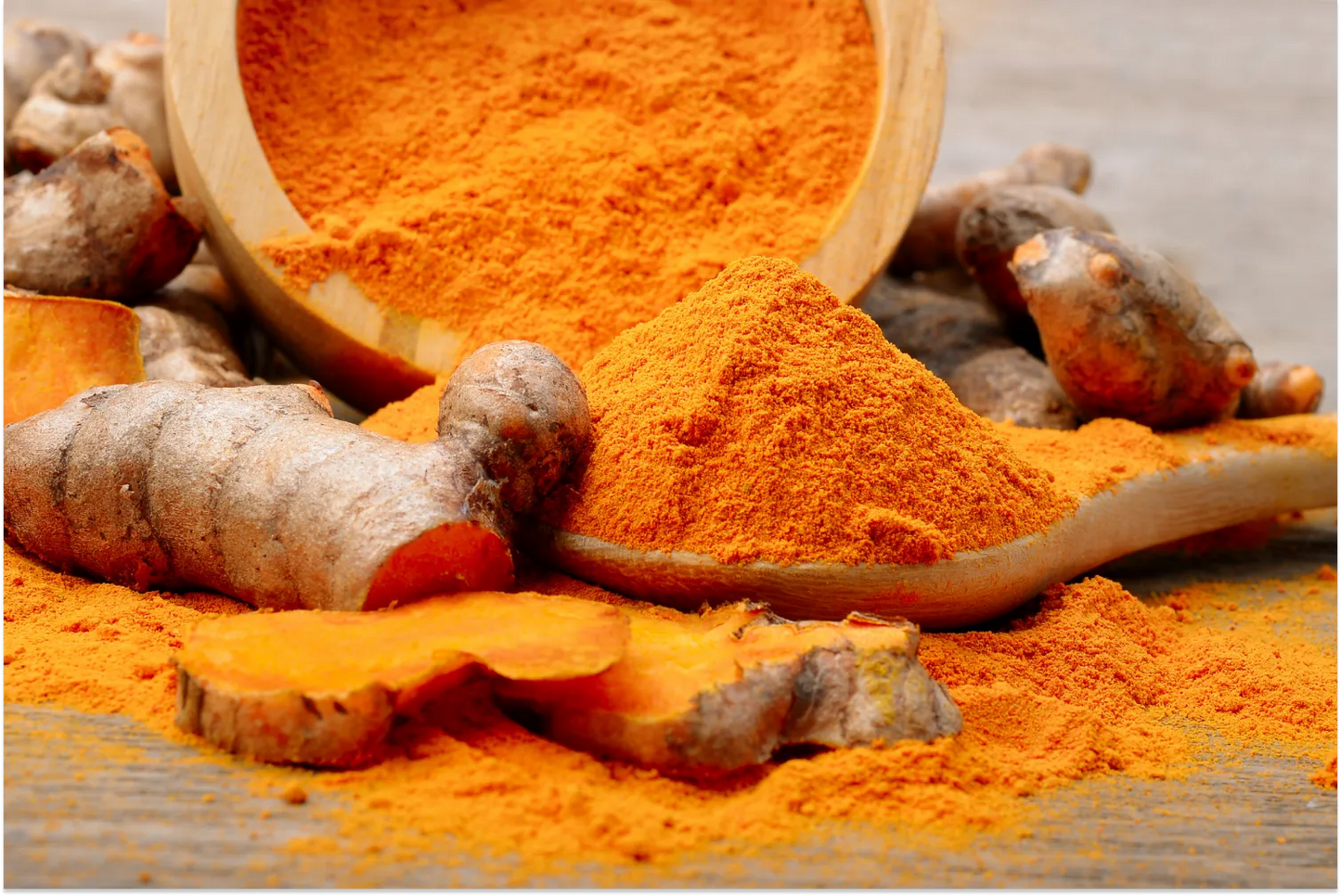
What Does Turmeric Taste Like?
Have you ever been out to a restaurant and caught a waft of something intriguing? You’re not sure what it is, but your nose is telling your mouth that you need to try it!
Depending on where you eat, the mysterious scent might have been turmeric. The spice has recently exploded in popularity, as it not only boasts a fascinating taste, but it’s chock full of health benefits, too.
Let’s take a deep dive into this vibrant spice to learn more about its history, taste, and benefits. Then, we’ll give you a few recipes so that you can try it out for yourself.
What Is Turmeric?
Turmeric is a rhizome, which makes it a close relative to the more familiar spice of ginger. However, turmeric is highly distinguished by its brilliant yellow-orange hue, which is why it's earned the nickname of the “Golden Spice.”
Not only is turmeric known for adding a splash of color, but its distinct flavor, a melange of mild bitterness and earthy warmth, has spiced up countless dishes around the world.
There are several varieties of turmeric, from the mild Madras turmeric to the more pungent Alleppey variety. Hailing predominantly from the fertile lands of India and Southeast Asia, turmeric thrives in tropical climates, with its cultivation deeply rooted in cultural traditions.
A Brief History of Turmeric
Dating back over 4,500 years, turmeric's journey began in the lush terrains of Southeast Asia. Beyond its culinary appeal, its radiant hue made it a prized possession in ancient times.
Tales from yesteryears speak of turmeric being a significant part of cultural rituals. In some traditions, it was believed to ward off evil spirits, and in others, it played a role in rites of passage.
In modern times, it’s still often used in many South Asian weddings. Some cultures involve a dedicated ceremony where turmeric paste is applied to the bride and groom, as it’s believed to bring prosperity and protection.
But there’s more to this golden root than meets the eye. Historically, it wasn’t just a kitchen staple; it also found a special place in traditional remedies. Ancient Ayurvedic medicine texts praised turmeric for its properties that can support overall well-being.
What Is Curcumin?
Curcumin is very often the first word that you’ll see when you dive into the essence of turmeric. So, what exactly is it? Well, curcumin is the primary bioactive compound found in turmeric, responsible for its vibrant hue and many of its supportive properties.
It’s easiest to think of turmeric as a treasure chest, and curcumin is the most precious gem inside. In fact, this “gem” is so desired that you can find curcumin extract almost anywhere that sells spices.
The extraction of curcumin from turmeric is an intricate process:
- First, the turmeric rhizomes are harvested, cleaned, and dried.
- The dried turmeric is then subjected to a solvent extraction process, usually with ethanol or water.
- As the solvent percolates through the powdered turmeric, it draws out the essential compounds, including curcumin.
- The solution is then evaporated, leaving behind a concentrated curcumin extract.
It’s this potent extract that scientists and health enthusiasts alike are often raving about, given its role in supporting various facets of our health.
Vitamin and Mineral Content
Turmeric is a powerhouse when it comes to its nutrient content. Its nutritional profile includes:
- Vitamin C: Not only does this potent antioxidant support our immune system, but it also plays an instrumental role in collagen production.
- Iron: Iron is pivotal in the formation of red blood cells, which transport oxygen to every nook and cranny of our body.
- Vitamin B6: Also known as pyridoxine, vitamin B6 is intricately involved in over 100 enzyme reactions, primarily related to protein metabolism.
- Potassium: An electrolyte by nature, potassium is fundamental for supporting muscle contractions and maintaining a rhythmic heart rate.
- Manganese: Often overshadowed by other minerals, manganese assists in the formation of connective tissues and bones.
- Fiber: Fiber is a powerful ally when it comes to digestion, ensuring everything moves smoothly through our GI tract.
What Does Turmeric Taste Like?
Navigating the culinary world often feels like an adventurous journey, with each spice offering a unique flavor story. When it comes to turmeric, its taste is a fascinating blend, reminiscent yet distinct.
Imagine the warm, spicy undertones of ginger and the tangy bite of mustard, coupled with a peppery kick. Add to this a subtle hint of bitterness similar to raw cocoa, a warmth that may remind you of a mild cinnamon, and an earthy base note, and you've captured the essence of turmeric.
How Can You Use Turmeric in Cooking?
Turmeric is a culinary gem that is not just limited to traditional dishes. Its vibrant hue and unique flavor can effortlessly elevate a variety of recipes. Let's explore some delicious ways to incorporate turmeric into your daily meals:
Golden Milk
Often called a "turmeric latte,” golden milk is a traditional Indian drink renowned for its tension-soothing properties. It’s a delicious nightcap for those seeking a comforting, warm beverage before bedtime.
Ingredients:
- 1 cup of almond/coconut/oat milk
- 1 teaspoon turmeric powder or freshly grated turmeric
- A pinch of black pepper (helps with absorption)
- Sweetener of choice: honey, maple syrup, or coconut sugar
- Optional: 1/4 teaspoon of cinnamon or cardamom for added flavor
Directions:
- In a saucepan, gently heat the milk.
- Whisk in the turmeric, black pepper, and optional spices.
- Simmer for a few minutes, ensuring it doesn’t boil.
- Sweeten to taste, serve in a mug, and enjoy the golden glow of this delightful drink.
Turmeric Roasted Vegetables
This is an effortless way to add a dash of health and color to your daily veggies. The earthy tones of turmeric complement the natural flavors of the vegetables, making it a staple in many kitchens.
Ingredients:
- Assorted veggies (carrots, bell peppers, broccoli, cauliflower, and zucchini work great)
- 2 tablespoons of olive oil or melted coconut oil
- 1 to 2 teaspoons of turmeric powder
- Salt and freshly cracked black pepper to taste
Directions:
- Preheat your oven to 425°F (220°C).
- In a large bowl, toss the vegetables in oil, turmeric, salt, and pepper, ensuring they’re well-coated.
- Spread them out on a baking sheet in a single layer.
- Roast for 20 to 25 minutes or until the vegetables are tender and slightly crispy.
- Garnish with fresh herbs like cilantro or parsley, if desired, and serve warm.
Turmeric Tea
Also known as "golden tea,” this beverage is a comforting way to enjoy the benefits of turmeric.
Ingredients:
- 1 cup almond/coconut milk
- ½ teaspoon turmeric
- ½ inch ginger root (peeled and grated)
- Dash of pepper (black or red)
- 1 teaspoon honey/maple syrup/coconut sugar/stevia/monk fruit
Directions:
- Heat up the milk in a saucepan over medium heat.
- Place other ingredients in a mug.
- Add a few teaspoons of warm milk and stir to combine.
- Pour in the remaining milk.
- Strain to remove ginger pieces (optional).
Smoothies
Add a health kick to your morning smoothie routine. The subtle taste of turmeric pairs brilliantly with fruits, making it a great addition.
Ingredients:
- 1 cup of your favorite fruits (banana, mango, and berries work wonderfully)
- 1/4 teaspoon turmeric powder or a small piece of fresh turmeric
- 1 cup milk or yogurt (dairy or plant-based)
- Sweetener, to taste (optional)
- Optional add-ins: chia seeds, flax seeds, protein powder, or Dr. Kellyann Collagen Peptides
Directions:
- Toss everything into a blender.
- Blend on high until the mixture is creamy and smooth.
- Pour into a glass and enjoy your vibrant, health-packed smoothie!
Curry
Curry is the classic use for turmeric, and it’s typically how people are first introduced to the spice.
Ingredients:
- 2 tablespoons vegetable oil
- 1 large onion, finely chopped
- 2 ripe tomatoes, finely chopped
- 2 teaspoons turmeric powder
- 1 teaspoon cumin powder
- 1 teaspoon coriander powder
- 1 teaspoon garam masala
- Salt to taste
- 500g vegetables (like potatoes, peas, carrots, beans), chicken pieces, or fish
- 1-= to 2 cups water or broth, as needed
- Fresh coriander leaves for garnish
Directions:
- Heat the vegetable oil in a deep pan or pot over medium heat.
- Add the chopped onion to the pot and sauté.
- Add the finely chopped tomatoes to the pan. Sauté until the tomatoes are soft and well-integrated with the onions to create the “masala” or base of the curry.
- Mix in the turmeric, cumin, coriander, and garam masala. Stir well.
- Now, introduce your main ingredient, whether it’s vegetables, chicken, or fish. Stir well.
- Pour in the water or broth and bring the curry to a simmer.
- Reduce the heat to low and let the curry simmer for 15 to 30 minutes.
- Season with salt to taste.
- Just before serving, garnish the curry with fresh coriander leaves for an added layer of flavor and a pop of color.
- Serve your turmeric curry hot with warm rice or fresh bread.
What Are the Benefits of Adding Turmeric to Your Everyday Diet?
Just like how we all love unwinding with a cozy beverage after a long day, why not make that drink work for our bodies? Adding turmeric to your daily routine can support various aspects of our health.
Its benefits include:
- Supports digestive health: Turmeric contains active compounds that can encourage a balanced stomach environment, aiding in smooth digestion. It can assist in easing bloating and discomfort, making those meals much more enjoyable.
- Full of antioxidants: Turmeric is packed with powerful antioxidants that can aid the body's natural defense system. These antioxidants can counteract free radicals, preventing them from causing damage to our cells and tissues.
- Supports mood regulation: The active compounds in turmeric can influence neurotransmitter functions in the brain, helping to maintain a balanced and positive mood.
- Bolsters heart health: Turmeric supports cardiovascular function by maintaining the health of the blood vessels, thereby supporting overall heart health.
- Encourages immune function: Especially relevant during changing seasons, turmeric can bolster the body's natural immune responses, preparing us against common illnesses.
- Supports skin health: A secret to radiant skin, turmeric can help combat skin issues, giving a natural glow and promoting healthier skin.
Introducing Dr. Kellyann’s Fast Track Bone Broth
If you’re looking to further support your wellness, then we’re excited to introduce you to Dr. Kellyann's Fast Track Bone Broth.
Specifically formulated to complement intermittent fasting routines, this high-protein, low-calorie broth offers a unique blend of ingredients. Not only does it champion weight loss, but it can also help you feel fuller for longer and support a healthy blood sugar.
But its benefits don’t stop there. Our recipe is also gluten-free, grass-fed, keto-friendly, non-GMO, and soy-free. You can experience all of the benefits of bone broth without worrying about harmful additives.
How To Use:
- To savor this delightful broth, simply pour a packet into your favorite mug.
- Add eight to 12 oz of boiling water and stir until blended seamlessly.
- If you’re looking to jazz it up, toss in some turmeric or some of your other favorite spices.
The Bottom Line
Turmeric is truly a golden gift from nature, as it offers a variety of culinary and health advantages. For those looking to enjoy the benefits, trying Dr. Kellyann's Fast Track Bone Broth can be a brilliant choice.
The cherry on top is our 60-day happy stomach guarantee. If this golden concoction doesn't sweep you off your feet in two months, you can claim a full refund (minus shipping).
Here’s raising a mug to a life brimming with flavor and health. Cheers!
Sources:
Ayurvedic Medicine: In Depth | NCCIH








